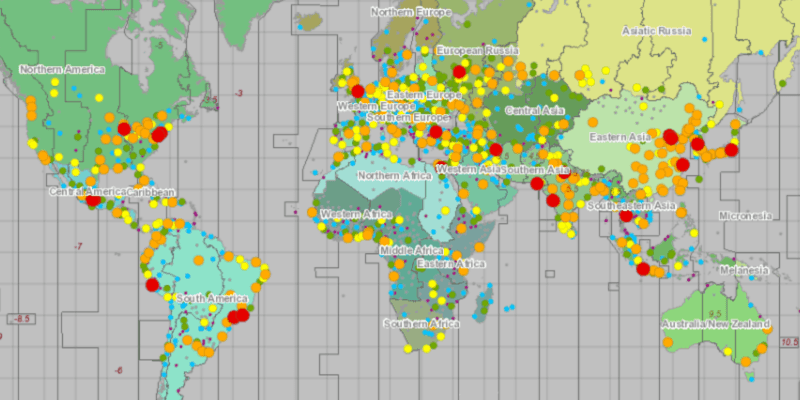Display a layer from a Web Map Tile Service.

Use case
WMTS services can have several layers. You can use ArcGIS Runtime to explore the layers available from a service. This would commonly be used to enable a browsing experience where users can choose which layers they want to display at run time.
How to use the sample
Pan and zoom to explore the WMTS layer, which is displayed automatically.
How it works
- Create a
WmtsServiceusing the URL of the WMTS Service. - After loading the WMTS service, get the list of
WmtsLayerInfosfrom the service info:service.getServiceInfo().getLayerInfos() - Use one of the layer infos to create a new
WmtsLayer(layerInfos.get(0)) - Set it as the map's basemap with
map.setBasemap(new Basemap(wmtsLayer)).
Relevant API
- WmtsLayer
- WmtsLayerInfo
- WmtsService
- WmtsServiceInfo
About the data
The map visualizes world time zones.
Tags
layer, OGC, raster, tiled, web map tile service
Sample Code
WmtsLayerSample.java
/*
* Copyright 2017 Esri.
*
* Licensed under the Apache License, Version 2.0 (the "License"); you may not
* use this file except in compliance with the License. You may obtain a copy of
* the License at
*
* http://www.apache.org/licenses/LICENSE-2.0
*
* Unless required by applicable law or agreed to in writing, software
* distributed under the License is distributed on an "AS IS" BASIS, WITHOUT
* WARRANTIES OR CONDITIONS OF ANY KIND, either express or implied. See the
* License for the specific language governing permissions and limitations under
* the License.
*/
package com.esri.samples.wmts_layer;
import java.util.List;
import javafx.application.Application;
import javafx.scene.Scene;
import javafx.scene.control.Alert;
import javafx.scene.layout.StackPane;
import javafx.stage.Stage;
import com.esri.arcgisruntime.layers.WmtsLayer;
import com.esri.arcgisruntime.loadable.LoadStatus;
import com.esri.arcgisruntime.mapping.ArcGISMap;
import com.esri.arcgisruntime.mapping.Basemap;
import com.esri.arcgisruntime.mapping.view.MapView;
import com.esri.arcgisruntime.ogc.wmts.WmtsLayerInfo;
import com.esri.arcgisruntime.ogc.wmts.WmtsService;
import com.esri.arcgisruntime.ogc.wmts.WmtsServiceInfo;
public class WmtsLayerSample extends Application {
private MapView mapView;
private WmtsService wmtsService; // keep loadable in scope to avoid garbage collection
@Override
public void start(Stage stage) {
try {
// create stack pane and application scene
StackPane stackPane = new StackPane();
Scene scene = new Scene(stackPane);
// set title, size, and add scene to stage
stage.setTitle("WMTS Layer Sample");
stage.setWidth(800);
stage.setHeight(700);
stage.setScene(scene);
stage.show();
// create a map and add it to the map view
ArcGISMap map = new ArcGISMap();
mapView = new MapView();
mapView.setMap(map);
// create a WMTS service from a URL
String serviceURL = "https://sampleserver6.arcgisonline.com/arcgis/rest/services/WorldTimeZones/MapServer/WMTS";
wmtsService = new WmtsService(serviceURL);
wmtsService.addDoneLoadingListener(() -> {
if (wmtsService.getLoadStatus() == LoadStatus.LOADED) {
WmtsServiceInfo wmtsServiceInfo = wmtsService.getServiceInfo();
// get the first layer's ID
List<WmtsLayerInfo> layerInfos = wmtsServiceInfo.getLayerInfos();
// create the WMTS layer with the LayerInfo
WmtsLayer wmtsLayer = new WmtsLayer(layerInfos.get(0));
map.setBasemap(new Basemap(wmtsLayer));
} else {
Alert alert = new Alert(Alert.AlertType.ERROR, "Failed to load WMTS layer");
alert.show();
}
});
wmtsService.loadAsync();
// add the map view to stack pane
stackPane.getChildren().addAll(mapView);
} catch (Exception e) {
// on any error, display the stack trace.
e.printStackTrace();
}
}
/**
* Stops and releases all resources used in application.
*/
@Override
public void stop() {
if (mapView != null) {
mapView.dispose();
}
}
/**
* Opens and runs application.
*
* @param args arguments passed to this application
*/
public static void main(String[] args) {
Application.launch(args);
}
}